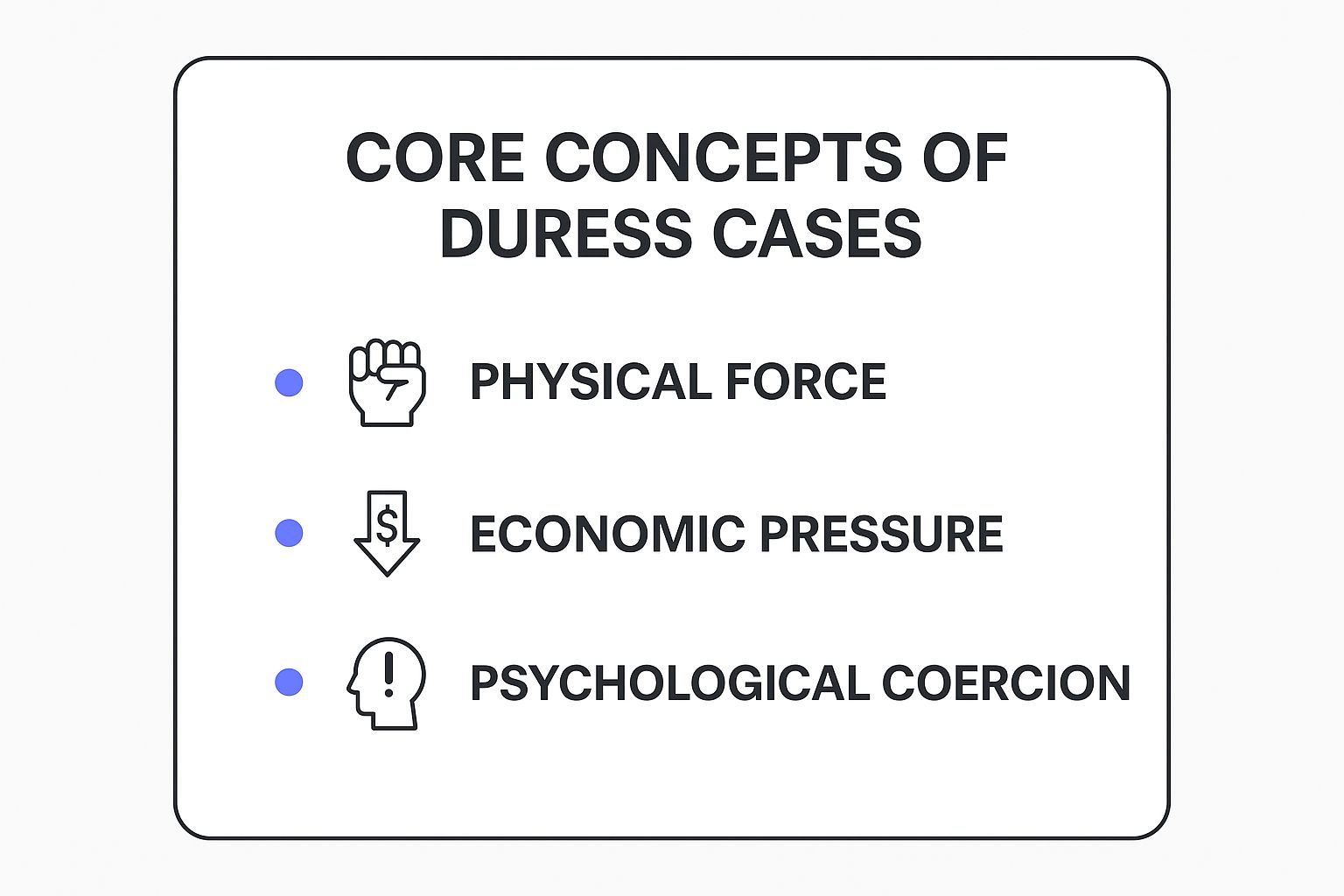
Picture this: someone holds a completely unfair threat over your head, pressuring you to sign a contract you'd never agree to otherwise. That's the heart of what it means to act ‘under duress’—being forced into a decision you wouldn't have made with your own free will.
This concept is absolutely fundamental in contract law. It's the legal system's way of making sure that when people enter into agreements, they're doing it willingly.
What It Really Means to Act Under Duress

Think of duress as the legal shield against coercion. It isn't just about feeling a little bit of pressure from a pushy salesperson. We're talking about threats or force so significant that you feel like you have no other reasonable choice but to go along with it. Your back is against the wall.
For any agreement to be legitimate, the law requires a genuine "meeting of the minds," where both sides agree freely and voluntarily. When one person is forced into it, that essential consent is gone.
U.S. case law has consistently held that duress involves pressure so intense that it completely shatters a person's free will, causing them to do something they normally wouldn't. If you want to dive deeper, you can explore the legal framework for duress cases to see how courts have defined these principles over time.
The Legal Test for a Duress Claim

Not all pressure is created equal, and not every tough negotiation counts as duress. Courts have a high bar for these claims, looking for specific ingredients that separate illegal coercion from aggressive—but perfectly legal—deal-making.
The core question a court will ask is this: was the threat so intense that it completely shattered your ability to exercise free will? It’s not just about feeling pressured. You have to show that you genuinely believed you had no other reasonable choice but to agree.
When it comes to contract law, proving duress is a powerful defense. You need to demonstrate that a contract exists, you were subjected to a compelling threat, and its urgency left you with no real alternative. If you can prove it, the contract can be voided, freeing you from its obligations. You can discover more insights about these requirements from the Corporate Finance Institute.
Common Types of Duress You Might Face
When people hear the word "duress," they often picture a scene straight out of a movie—someone being physically forced to sign a document. While that certainly counts, most real-world duress is far more subtle and comes in a few different flavors.
It’s crucial to know how to spot these less obvious forms of pressure. The main categories you’ll run into are physical, economic, and emotional duress. For example, a massive corporation could corner a small business owner by threatening to cut off all future business unless they agree to an unfair contract. That’s a classic case of economic duress.

As you can see, illegal pressure isn't always about physical harm. It can just as easily target your financial stability or even your psychological well-being. Getting a handle on these tactics is a key part of learning how to avoid lawsuits that arise from coerced agreements.
Comparing Different Forms of Duress
To give you a clearer picture, let's break down the different types of duress. This table compares their core characteristics, making it easier to identify what you might be up against in a real-world scenario.
| Type of Duress | Nature of the Threat | Common Example |
|---|---|---|
| Physical Duress | Direct threats of violence or bodily harm to a person or their family. | Forcing someone to sign a will by threatening physical injury. |
| Economic Duress | Threats to a person's financial interests, business, or property. | A supplier threatening to withhold critical materials unless a business owner accepts a massive price hike. |
| Emotional Duress | Threats or manipulation that exploit a person’s psychological vulnerabilities. | Using blackmail or threatening to reveal damaging personal secrets to coerce someone into an agreement. |
Recognizing these patterns is the first step toward protecting yourself. Whether it’s an explicit threat or a subtle manipulation, any agreement made under duress lacks the genuine consent needed to be legally binding.
How Duress Plays Out in the Real World

Legal theory is one thing, but to really get a handle on what does under duress mean, you have to see how it shows up in real life. These aren't just abstract ideas; they're high-stakes situations that can turn a person's world upside down.
Take the case of an elderly person being emotionally cornered by a family member. Imagine a relative threatening to move them into a nursing home unless they agree to rewrite their will, leaving that relative a much larger inheritance. There’s no physical weapon, but the emotional pressure is immense—so immense, in fact, that it could be enough to get the will thrown out in court.
It's not always about money, either. Consider a scenario where someone is forced to act as a getaway driver for a bank robbery. They don't want to do it, but the criminal has made a credible threat to harm their family if they refuse. The immediate and serious danger leaves them with no other realistic choice. This is a classic setup for a duress defense in a criminal case.
The Legal Consequences of Proving Duress
So, what happens if you successfully prove you were forced into a deal? The legal system provides some powerful remedies. The main consequence is that the contract becomes voidable. This is a crucial distinction—it doesn't just evaporate on its own. Instead, the power shifts entirely to you, the victim.
This means you get to call the shots. You can choose to either walk away from the agreement, making it legally null and void, or you can decide to uphold it if, for some reason, it still works in your favor. On top of that, you might also be entitled to restitution. This legal principle is all about making you whole again by recovering any money or property you lost because of the coerced agreement.
A voidable contract is like having a "return" option on a bad purchase. You can either keep the deal if it somehow benefits you, or you can send it back to nullify it completely.
While it can be tough to pin down exact numbers, some legal market analyses suggest that 10-15% of contract disputes involve claims of duress. This shows just how relevant this issue is in the business world. You can discover more insights about duress cases at LegalMatch. For a more detailed guide, check out our article on duress in contracts.
What to Do If You're Facing Duress
If you feel like you're being backed into a corner and forced to sign something, it’s vital to act quickly but carefully to protect your legal standing. Your immediate safety is always the top priority, but you also need to think strategically about what comes next.
Start by documenting everything. Keep a detailed log of every threat, intimidating conversation, or coercive action. Save any relevant emails, text messages, or voicemails—this kind of concrete proof can be invaluable down the road. If it feels safe enough to do so, clearly and firmly state your objection to being pressured.
The single most important thing you can do is get professional legal advice right away. An attorney can look at the specifics of your case, explain what "under duress" means for you, and give you a clear plan to protect your rights and seek a just outcome.
Digging Deeper: Common Questions About Duress
Let's clear up a few common points of confusion that often come up when we talk about duress.
Is Threatening to Sue Someone Considered Duress?
Usually, the answer is no. Threatening to do something you have a legal right to do—like filing a lawsuit—doesn't typically count as duress. Think of it this way: duress hinges on improper or unlawful threats. Since suing someone is a lawful action, a threat to do so generally won't void a contract.
What Is the Difference Between Duress and Undue Influence?
This is a great question because the two can seem similar. The key difference is the method of pressure.
Duress is all about a direct threat of harm. It’s overt and often immediate—think physical threats, economic blackmail, or emotional coercion. It’s a "gun to the head" scenario, whether literal or figurative.
Undue influence, on the other hand, is far more subtle. It happens when one person uses a special relationship of trust or authority to unfairly persuade another. It's less of a threat and more of a manipulation, eroding the person's free will over time.
How Long Do I Have to Challenge a Contract?
You need to act fast. There are strict deadlines, known as statutes of limitation, for filing legal claims. If you wait too long, the court might also apply a legal principle called laches, which basically says you've lost your right to a claim because of an unreasonable delay.
For a complete overview of similar topics, check out our guide on common legal terms explained.
Struggling to make sense of complex legal language? Legal Document Simplifier uses AI to instantly translate dense contracts, leases, and agreements into clear, simple summaries. Upload your document today and get the clarity you need to make confident decisions. Learn more at Legal Document Simplifier.